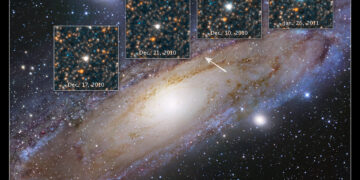One hundred years ago, Edwin Hubble redefined humanity’s understanding of the cosmos with a single groundbreaking observation. Using the 100-inch Hooker Telescope at Mount Wilson Observatory, Hubble identified a Cepheid variable star, V1, in the Andromeda galaxy.
The Discovery That Transformed Astronomy
In 1923, Edwin Hubble peered through the largest telescope of his time to examine the Andromeda “nebula,” a celestial object then believed to be part of the Milky Way. Within this hazy structure, he found V1, a Cepheid variable star. This particular class of stars had already been identified as vital cosmic tools by Henrietta Swan Leavitt, who discovered a direct relationship between their pulsation periods and intrinsic brightness.
Using Leavitt’s work, Hubble calculated the distance to V1. The results were astonishing: Andromeda lay far beyond the boundaries of the Milky Way, proving it to be a galaxy in its own right.
Hubble’s discovery settled a heated debate among astronomers about the nature of “spiral nebulae.” Many believed these objects were star-forming regions within the Milky Way, but Hubble’s data definitively placed Andromeda—and by extension, other nebulae—far outside our galaxy.
The Role of Cepheid Variables: The Universe’s Mileposts
Cepheid variables are pulsating stars that rhythmically change in brightness. The relationship between their pulsation period and luminosity, discovered by Leavitt, allows astronomers to determine their absolute brightness. By comparing this with their apparent brightness, scientists can calculate their distance with remarkable accuracy.
Hubble’s use of V1 as a cosmic milepost marked the beginning of the “cosmic distance ladder.” This method remains a cornerstone of astronomical measurements, enabling scientists to map the vast expanse of space.
Hubble’s Expanding Universe: A Paradigm Shift
In the years following his discovery of V1, Hubble made another revolutionary observation. By studying the redshift of galaxies—light stretched to longer wavelengths as objects move away—he found that galaxies are receding from Earth at speeds proportional to their distance. This phenomenon, now known as Hubble-Lemaître’s Law, provided the first direct evidence of an expanding universe.
Hubble’s findings, supported by earlier redshift data from Vesto Slipher, revolutionized cosmology. The idea of an expanding universe led to the development of the Big Bang theory, offering a scientific explanation for the universe’s origins and evolution.
The Legacy of Edwin Hubble
In 1990, NASA launched the Hubble Space Telescope, a fitting tribute to the astronomer whose work expanded our horizons. Orbiting above Earth’s atmosphere, the telescope has captured breathtaking images of galaxies, nebulae, and exoplanets. Its observations have deepened our understanding of phenomena like black holes, dark matter, and the universe’s age.
Hubble’s work laid the foundation for determining the rate of cosmic expansion, known as the Hubble Constant. Precise measurements using the Hubble Space Telescope have helped scientists estimate the universe’s age at 13.8 billion years. This calculation required establishing the first rung of the cosmic distance ladder, using Cepheid variables like V1 as foundational reference points.
Modern Challenges and Future Explorations
In 1998, observations from the Hubble Space Telescope revealed that the universe’s expansion is accelerating due to an enigmatic force called dark energy. This discovery added a new layer of complexity to cosmology, challenging existing models and sparking ongoing research into the nature of dark energy and its impact on the cosmos.
As we celebrate the centennial of Hubble’s discovery, the next era of exploration is on the horizon. The James Webb Space Telescope and the upcoming Nancy Grace Roman Space Telescope promise to delve deeper into questions about galaxy formation, dark energy, and the early universe.
Reflections on a Century of Discovery
Edwin Hubble’s discovery of V1 was more than a scientific breakthrough; it was a paradigm shift that redefined humanity’s place in the universe. By proving that the cosmos extends far beyond the Milky Way, Hubble opened the door to a century of exploration and discovery.
Hubble’s work continues to inspire astronomers and dreamers alike. From the Cepheid variable V1 to the Hubble Space Telescope’s far-reaching observations, his legacy is a testament to the power of curiosity and determination.
Conclusion: Celebrating a Legacy of Exploration
A century after Edwin Hubble identified V1 in the Andromeda galaxy, his discoveries remain a cornerstone of modern astronomy. They reshaped our understanding of the universe, revealing a dynamic, ever-expanding cosmos.









![Gamma-ray burst [GRB]. Credit: Cruz Dewilde/ NASA SWIFT.](https://nasaspacenews.com/wp-content/uploads/2025/05/gamma-ray-burst-credit-nasa-swift-cruz-dewilde-1-75x75.jpg)









